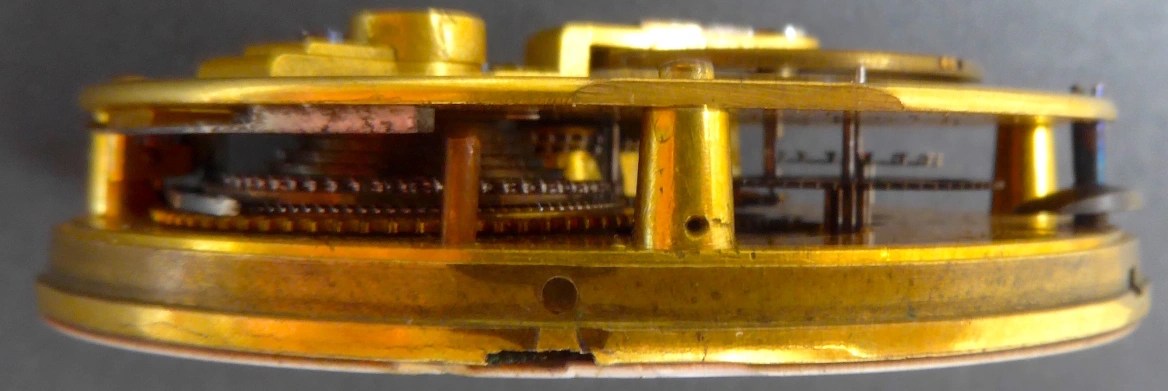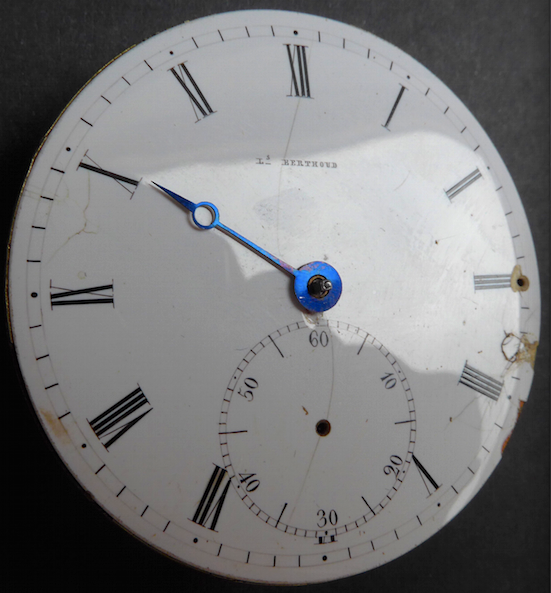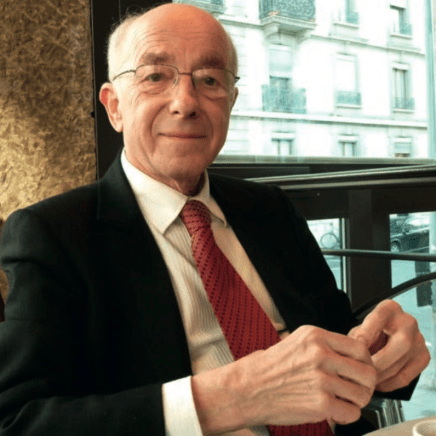


Description: Gilt brass, full plate, steel cylinder movement (47.5mm diameter). Brass three arm balance with blued steel balance spring. Balance held by a single bridge with steel cockerel holding a sapphire end stone. Fusee with Harrison’s maintaining power. Long steel regulator hand, regulator index engraved onto the backplate. Backplate engraved ‘Louis Berthoud A PARIS, No. 2520’. The movement has been modified at manufacture from a hinged system to an unhinged system for casing. Enamelled copper dial with Roman numerals and seconds subdial at 6 o’clock. Dial signed ‘L(oui)s BERTHOUD’ at 12. Blued steel hour hand of early, flat ‘Breguet’ style. Lacking Minute and second hand.
Additional Info:
A rare survivor of Louis Berthoud’s simple watch movements. He was mostly responsible for the manufacture of pocket and and later of marine chronometers. Interestingly this watch has one of George Harrison’s most widely adopted innovations for pocket watches in England: Harrison’s maintaining power. This is the only French watch known to us which includes this feature.
The dating is confirmed by watch No. 2521, a quarter repeating, pocket chronometer. Latter piece was sold to Monsieur Blanchard de Pigon the 20.3.1793 for the sum of 70 Louis d’Or – one of the earliest French watches to be fitted with pierced jewels (sold at Christie’s, 15.6.2011, Lot. 153).
Provenance: Ex private collection Jean – Claude Sabrier (F)
Jean – Claude Sabrier (1938 – 29.11.2014)

Passionate about horology, immensely hard-working, ever helpful to colleagues and friends, imbued with a sense of the absurd, and generally always in high good humour, Jean-Claude Sabrier was a committed student – collector, retailer and historian – of clocks and watches in all their variety.
Scion of a family of jewellers, Sabrier soon abandoned this narrow field, establishing himself as a general antiques dealer in Normandy where he continued to reside for the rest of his life. At the same time he laid the foundations of the extensive knowledge of horology that would lead him to become one of the leading consultants for the subject in Europe. In 1980 he joined forces with Hervé Chayette in Paris to launch regular auctions exclusively devoted to horology. Such had never previously been attempted in France but, modelled on those conducted in London by Sotheby’s and Christie’s, they were held on a sustained basis twice or thrice a year from 1980 until 1988. Then, after being solicited by Sotheby’s Europe, Sabrier was seduced into joining the Genevan based firm of Antiquorum. There he remained until 2000.
The final years of his professional life were spent with the Swatch Group as advisor on the development of their patrimonial collections, in particular those of the private Breguet museum.
In parallel with such commercial activity, Jean – Claude Sabrier always continued historical research, based on both texts and objects. In addition he actively aided the staff of the several museums that he frequented, and collaborated in the mounting of some important exhibitions, in particular those devoted to Ferdinand Berthoud in Paris, Besançon and La Chaux-de-Fonds (1984), and the Le Roy family at Tours (1987).
It was however precision horology that came increasingly to dominate Sabrier’s attention, and it was in this field that he produced an enduring monument of detailed research in his study of Louis Berthoud and Henri Motel (1993), a work honoured by the Académie de la Marine. In 1997 he was awarded the Gaia Prize for the generality of his works, but several more were to follow, in particular the study devoted to Jacques – Frédéric Houriet (2006), and collaboration in the exhibition of Breguet watches mounted at the Hermitage Museum, St Petersburg (2004).

Sabrier has left an extensive private horological library and manuscripts mainly of French watchmakers and chronometry. His watch collection of mainly French makers focused on chronometry and included also an impressive collection of self winding watches and maybe the biggest collection of original and rare contemporary ‘copies’ of Breguet’s ‘souscription’ watches. In parallel he collected general scientific literature and objects focusing on the longitude problem and astronomy. His collection included also objects of vanity of different materials, its centre piece being a French ‘memento mori’ watch from the mid 1600.
Text and picture taken and modified after: Chayette & Cheval, catalogue sale 148: Original text credit: Anthony Turner, CNRS expert
